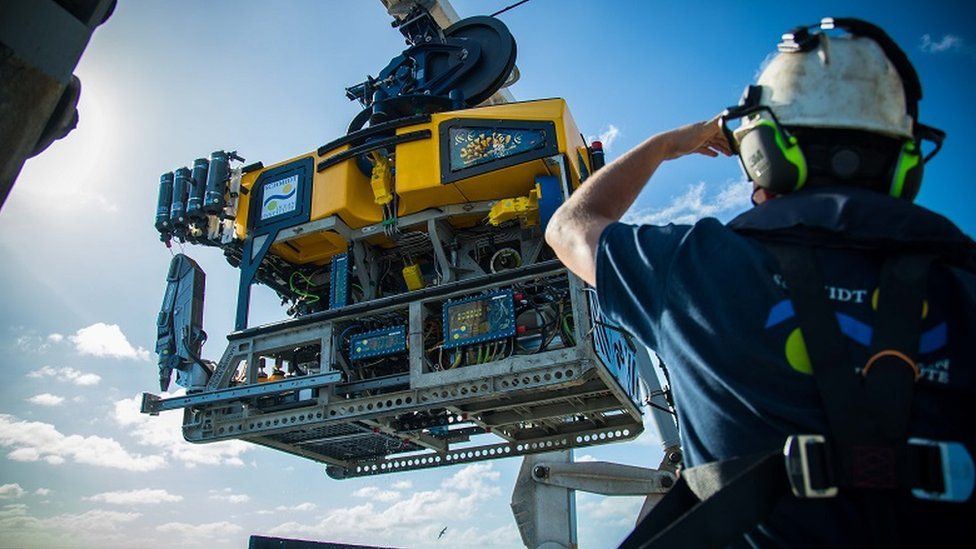Great Barrier Reef: Scientists find reef taller than Empire State Building
- Published

An enormous coral reef has been found at the northern tip of Australia's Great Barrier Reef, the first such discovery in 120 years, scientists say.
At 500m (1,640ft) high, the reef is taller than New York's Empire State Building and the Petronas Twin Towers in Kuala Lumpur, Malaysia.
Scientists on a 12-month mission found the structure, detached from the Great Barrier Reef off Cape York, last week.
They were conducting 3D mapping of the sea floor in the area.
A team aboard a research vessel owned by the Schmidt Ocean Institute (SOI), a non-profit group based in California, used an underwater robot to explore the reef.
Known as SuBastian, the robot live-streamed video of the discovery on Sunday and posted it to YouTube.
"To find a new half-a-kilometre tall reef in the offshore Cape York area of the well-recognised Great Barrier Reef shows how mysterious the world is just beyond our coastline," said SOI executive director Dr Jyotika Virmani.
"This powerful combination of mapping data and underwater imagery will be used to understand this new reef and its role within the incredible Great Barrier Reef World Heritage Area."
The Great Barrier Reef, the world's largest coral reef, is home to more than 1,500 species of fish, 411 species of hard corals and dozens of other species.
Stretching over 2,300km (1,400 miles), the reef was designated a World Heritage site in 1981 for its "enormous scientific and intrinsic importance".
But in recent years, it has been vastly damaged by warmer seas which have killed off coral, dispersed other marine life and sped up growth of algae and other contaminants.
A study published earlier this month found the Great Barrier Reef had lost more than half of its corals since 1995 due to warmer seas driven by climate change.
More on the Great Barrier Reef:
Drones and scientific facilities could help the reef
What do we know about the new reef?
The reef is the first of its kind to be found in the region since the late 1800s, scientists said. There are known to be seven other tall reefs in the region, including the one at Raine Island - the world's most important green sea turtle nesting area.
While the reef is bedded to the ocean floor off North Queensland, it is detached, meaning it is not part of the main body of the Great Barrier Reef.
Described as "blade-like", the reef is 1.5km wide (one mile), then rises 500m to its shallowest depth of only 40m below the sea surface.
"This unexpected discovery affirms that we continue to find unknown structures and new species in our ocean," said SOI co-founder Wendy Schmidt.
"The state of our knowledge about what's in the ocean has long been so limited. Thanks to new technologies that work as our eyes, ears and hands in the deep ocean, we have the capacity to explore like never before.
"New ocean-scapes are opening to us, revealing the ecosystems and diverse life forms that share the planet with us."
Researchers are expected to continue surveying the northern Great Barrier Reef until 17 November.
What else have researchers found?
The reef is the latest discovery to be made by researchers aboard the Falkor, a Schmidt Ocean Institute ship on a year-long exploration of oceans around Australia.
The institute said it had discovered up to 30 new species, including "the longest recorded sea creature", a 45m-long siphonophore found in April in a canyon off Western Australia's coast.
Relatives of jellyfish and coral, siphonophores are deep-sea organisms. Many are bioluminescent, glowing green or blue to lure prey.
More discoveries were made in August, including undescribed species of black coral and sponges and "Australia's first observation of rare scorpionfish", the institute said.
You may also be interested in:
Rowley Shoals: The bleached Australian reef and a Covid challenge
- Published14 October 2020
- Published15 September 2020
- Published7 October 2020